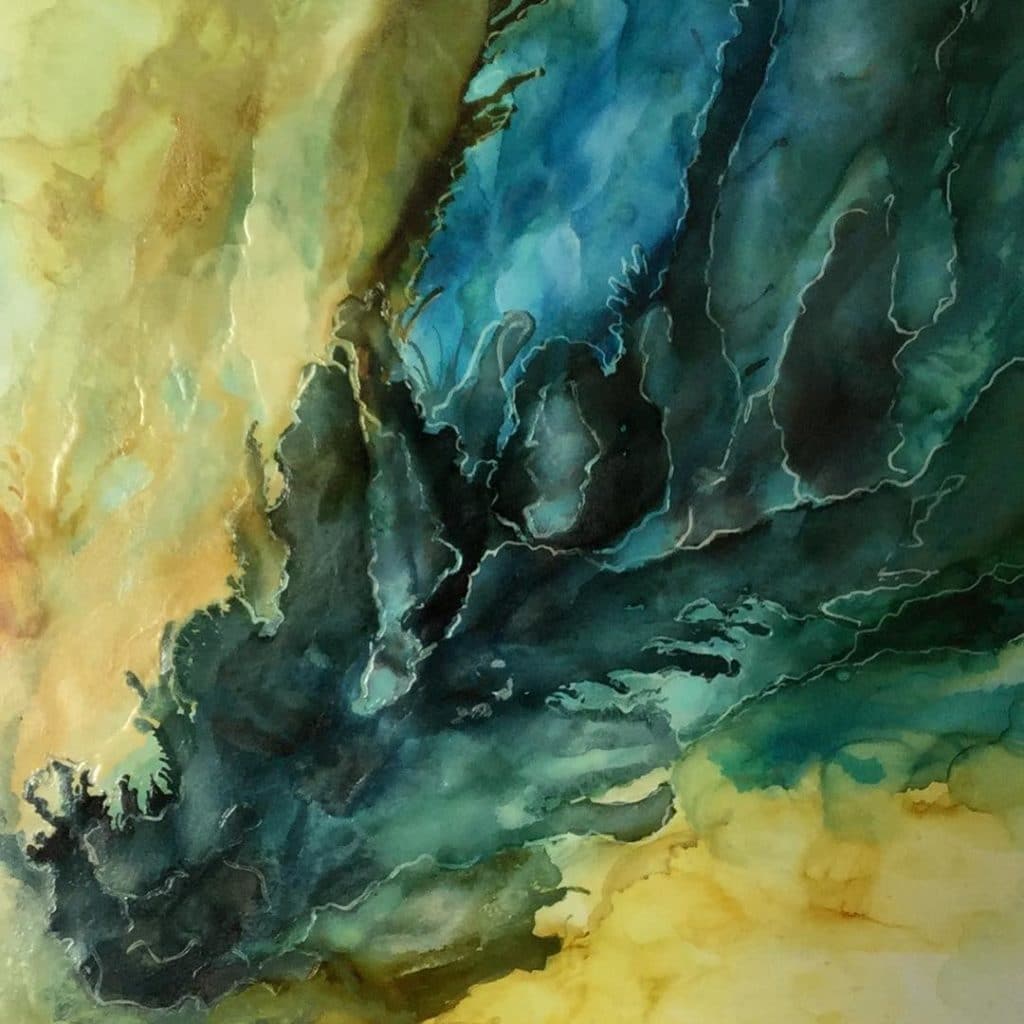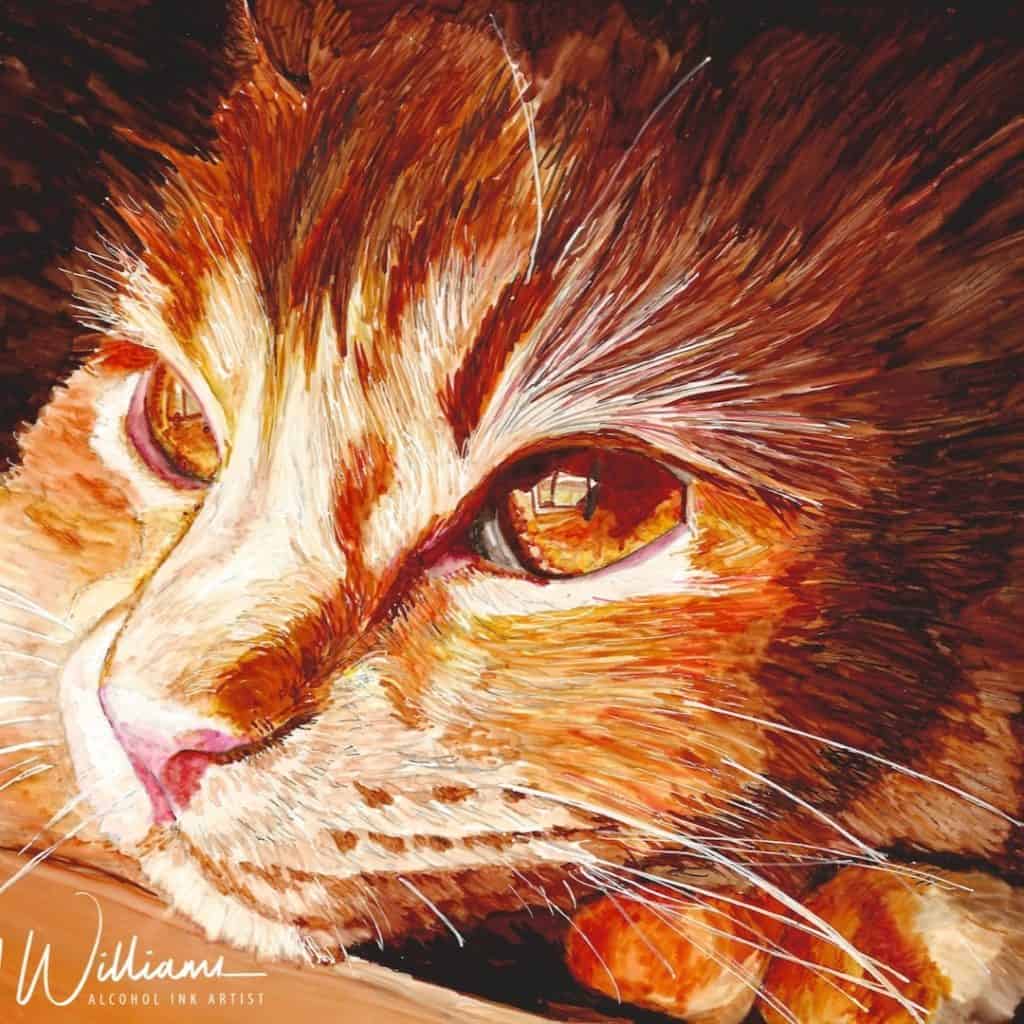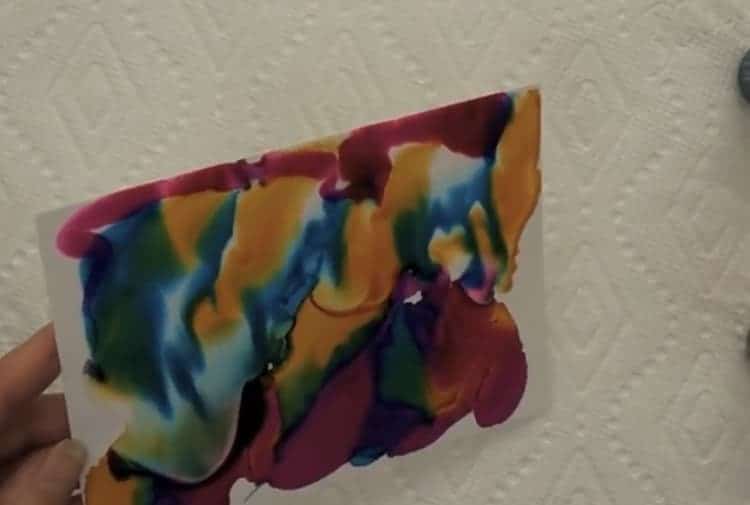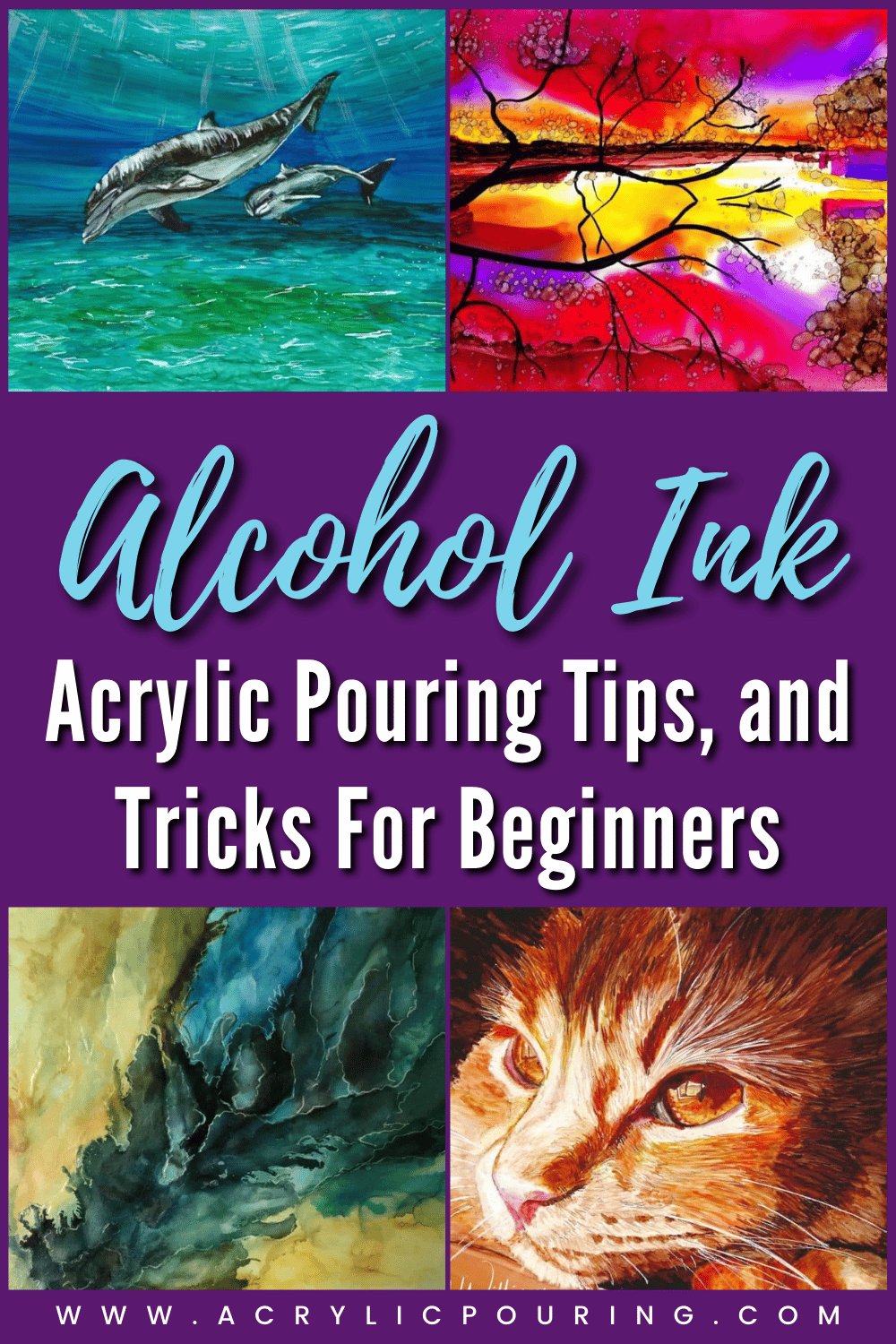Alcohol ink art is an incredibly fun and absolutely vibrant art form in which anyone can get involved, no matter their previous art experience. While alcohol inks can seem a little difficult to master at the beginning, I can assure you that they are rewarding and worth the journey of learning the medium. The possibilities are only limited to what you are willing to try. Here is your complete guide on how to use alcohol inks and produce amazing art work!

What is alcohol ink?
Before you can master anything, you need to know what it is. Alcohol ink is highly pigmented dye and, of course, alcohol based. These inks are manipulated using isopropyl alcohol (rubbing alcohol to you and me). As the inks are alcohol based they evaporate much quicker, so the paint dries in only a few minutes. However, once the ink is dry it can be “revived” to be processed and manipulated further. Because of the nature of these inks there is a variety of techniques and styles that are unique to alcohol inks, and which allow for an endless river of creation to continually flow.

What is alcohol ink art?
Alcohol ink art is one of the main members of the fluid arts family, which are composed of acrylic pouring, resin art, and alcohol inks. Fluid art is when you take a medium in liquid form and let the pigments run wild, creating abstract pieces. Indeed, alcohol inks fit nicely into this description as you can create magnificent abstract pieces by just letting the inks flow, and then controlling them using the different techniques described in this article. However, the beauty of alcohol inks is that they also allow you to create fantastic realistic pieces also. Whether you choose to make abstract art or realistic art, the possibilities are unlimited and you are bound by nothing– just let your creativity run.
Example of a more abstract alcohol ink piece:

Related: Alcohol Ink Abstract Art Course
Example of a more realistic piece:

Related: Alcohol Ink Beginners Course
Who is alcohol ink art good for?
Anyone can try, experiment and even master alcohol inks. Just like any new medium, you need to take the time to learn how it acts, and how it moves so you can really hone in on your skills and techniques.
If you have taken a liking to acrylic pouring, even if you have mastered it, alcohol inks may just be the next step for you. They can be a little more challenging due to the way they interact with each other, however they provide more control.
If you love water color art, but find it to be a little too difficult, you may want to experiment with alcohol inks. While the look can be similar, some of the basic principles are different compared to watercolors, so you first have to wrap your head around that. But once you do, you may find that you really enjoy the easier execution and vibrant nature of the art form.
Alcohol Ink Supplies
Don’t worry, like acrylic pouring, alcohol ink art doesn’t require a huge amount of supplies to get started. You can experiment and do a lot with only a few items! Here is a basic overview of the supplies you need to get started.
- Yupo paper
- Ceramic tile
- Tim Holz Adirondack Inks
- Pinata Inks
- Alcohol ink markers
- Blending solution
- Brushes
- Droppers
- Spray bottles
- Sponges
- Blending tools
Alcohol Ink Starter Kit
If you want to get started with the basics you can check out this alcohol ink starter kit below. It has everything you need to start including inks, alcohol ink specialized paper, blending solution, and blending tools:

Surfaces (Substrates)
One of the best things about alcohol ink is that it works well on a variety of mediums beyond traditional paper. Glass, wood, metals, ceramics, and plastics are all suitable mediums. Indeed, you can explore and get creative with ny non-porous substrate.
Yupo Paper
In regards to paper as a surface, it’s important to understand that alcohol inks can’t be used on normal paper as it is too porous. The dye would just be absorbed directly into the paper like a fountain pen and you won’t get those bright, vibrant, clean colors you want. To benefit from the unique look of alcohol inks, and to be able to manipulate them in ways that allow for their unique style, a special kind of glossy paper is needed.
Yupo paperis a special sheet that is made of polypropylene, it feels like a piece of flexible plastic. Available in white and transparent, as well as a variety of weights you have complete control over your project. For a beginner it is best to use white Yupo paper that is either 153 gsm (grams per square meter) or 200 gsm.
Did you know? Yupo paper is also tear and water resistant — you don’t have to worry about accidentally ripping your paper if you have tapped it down!
Yupo vs Ceramic Tile
For beginners, you can use either yupo or ceramic tile when it come to painting with alcohol inks. However, there are a few differences you need to be aware of as it can affect the color and how you protect your paintings.
The main difference is the ability to wipe back to white and how to frame your painting. Inks on Yupo will stain with a bit of color that can be used to enhance your painting. Inks on tile can be completely wiped back to white. Yupo can be sealed and framed as any fine art painting, tile must sealed and can be a challenge to mount and frame.
Depending on what you are after with your paintings, both can be incredibly advantageous to your overall masterpiece. Just get experimenting and see what you can do.
| Yupo Paper | Ceramic Tile |
| Ink stains the paper | Ink can be lifted back to white |
| Ink spreads further | Ink spreads less |
| Can seal with Krylon Kamar | Must seal with Krylon Kamar |
| Easy to mat and frame | Challenge to mat and frame |
In addition to paper, you can use alcohol inks on:
- Glass ie. wine glasses, tumblers etc
- Wood
- Metals
- Ceramics ie. tiles
- Glossy cardstock
- Plastic
- Canvas prepared for non-porous surface
- Whiteboards
For more info on substrates and comparisons check out the video below:
Tips
- When using the alcohol inks it is best to use a clear sealer or resin to prevent it from wiping off or running later on– that would be disastrous after all the hard work you have just put in! Two to three thin coats should do it. I recommend using Krylon Kamar for 2-3 coats then a UV sealer.
- You should touch your surface as little as possible, or avoid it completely and wear some rubber gloves. The natural oils in your skin can actually transfer to your surface and prohibit the inks from acting normal. Plus, wearing gloves means your hands won’t get stained!
Inks
Just like any art medium there are many brands and types of inks. They are often sold in 0.5oz bottles in a range of colors and dyes. A little goes a long way with this medium, you will be surprised just how little you need to create a beautiful piece of art. This is because it’s dye rather than pigment. The dye particles are very small and can be dispersed over a large area.
Adirondack Alcohol Inks
This is the main brand when it comes to alcohol inks. It is also known as Ranger Ink and it was created by Tim Holtz. Adirondack alcohol inks can be brought in packs of three. These packs are really useful for beginners as it takes some of the guesswork away when it comes to discovering what colors/dyes work well together and blend beautifully.
Besides their 60 color collection, Ranger Inks also has a metallic collectionthat can really liven up any piece. The metallic inks can be used to add highlights and even add texture. Be warned though, you can’t go in heavy with these as they can easily overpower a piece.
Jacquard Pinata Inks
Jacquard Pinata Inks are another go-to when it comes to alcohol inks. They are incredibly rich dyes and fast drying. Supplying a good variety of colors and even some beautiful metallic inks, you won’t be running out of options. Pinata Inks pride themselves on being highly saturated and using only the most lightfast dyes to ensure premium quality.
The Pinata Inks are another great option for beginners as you can buy a class pack, which provides you with a variety of colors, clean up solution and a few extra goodies. Getting started with alcohol inks has never been easier.
Tip
- For metallics, be sure to shake the bottle well before using to ensure that the product is mixed properly. There’s a ball bearing inside to help with mixing. Standard inks don’t need to be mixed.
Markers
If you aren’t one for a paintbrush and prefer more of a draw on style, there are even alcohol ink markers you can use! Markers can be great to use when you want more control and want to create detail.
You can use markers such as Sharpies to create details and outline once you have finished manipulating the inks. While Sharpies are considered “permanent” markers, artists know that they lose their permanency when used on the right paper and with rubbing alcohol. However, if sealed with Krylon Kamar and UV Protectant they stay permanent. White gel pens are also great when it comes to adding highlights to your piece as that final finishing touch.
Copic Markers
When it comes to alcohol based markers, this is most definitely a forerunner for most. They have incredible pigmentation and are really easy to use. You can purchase these in a variety of different packs with either a chisel nib, a brush nib or both! Copic has thought of everything to ensure that you get what you need.
Copic also allows you to purchase refills for the markers, or just use the refills for the ink with a brush! With 368 colors, you can get any tone or color combination you are after.
Sharpies
The good old Sharpiesare even alcohol based markers. These markers can give a little more variety in terms of colors as it has neon, metallic, pastel, and of course, the traditional collections.
Sharpies are great to use as a beginner tool, due to the popularity of the brand and the familiarity just about everyone has with the markers. You can just color and then use rubbing alcohol to marble and blur the lines. It turns out just gorgeous!
Blending solution and rubbing alcohol
Blending solution and rubbing alcohol is to alcohol inks what H2O is to watercolors. You absolutely need it and you are going to need a lot of it. Having a blending solution allows you to broaden your technical possibilities, your tones and allows your ink to go further.
A blending solution is made up of isopropyl alcohol and glycerine. You use this to dilute the inks to create a variety of tones and blend to create smooth transitions between dye. You can even use the solution to clean up the inks off of slick surfaces, tools, and your hands or dilute colors so much they eliminate the dye.
The two main brands for blending solution are the same as for inks:
You can also purchase pure isopropyl alcohol, commonly referred to as rubbing alcohol, instead or in combination with a blending solution. If you do decide to use rubbing alcohol, you’ll want to select a percentage that suits you. Higher percents like 99% can be used in extreme humidity while lower percentages like 70% alcohol may be fine in dry climates. Experiment a little or ask local alcohol ink artists to find out what works best in your location.
For a demonstration on how the proportion of ink to dye influences your work check out the video below:
Blending Tools
Blending Tools are very important with alcohol inks when you create representational paintings to blend and soften edges. The most popular blending tools are below. The difference in each tool is the size and flexibility of the tip. All except the Cotton Swabs can contain either alcohol or blending solution.
- Cotton Swabs
- Tsukineko Fantastix
- Water brushes
- Copic Colorless Blender
- Ranger Alcohol Ink Blending Pen
Alcohol Ink Application Supplies
When it comes to applying inks there is a variety of options at your disposal. The surface you are using and the type of art you want to complete will dictate which application method, or combination of methods you are going to use. Here are a few of the more common applicators when it comes to alcohol ink art:
Applying Alcohol Ink Techniques
There are many methods of applying ink to your surface and they each give you a different effect. I’ll cover some of the basic techniques below, but if you want a more comprehensive overview check out my alcohol inks for beginners course.
Push and Glide Technique
The first step in learning to control the alcohol inks is the Push and Glide technique. You learn the roll of the alcohol and how to allow some of the alcohol to evaporate off, leaving behind more intense color.
- Draw a basic shape
- Put some ink into a palette
- Dip your brush into the ink
- Place your brush into the center of the shape.
- Watch how far the ink moves towards the edges of your shape
- Use your brush to gently move ink in the shape towards the outside
The amount of alcohol in the ink will dictate how far the ink will move away from where you place it.
Drop/Pour Technique
This is the most basic method of applying alcohol inks. This can create really beautiful backgrounds and abstract designs.
- Take a sheet of your paper.
- Choose a minimum of three colors.
- Place a single drop straight from the bottle. See how it spreads out into a circle?
- Drop a new color to the first dot. See how new colors spreads and pushed the first color?
- Continue dropping your colors over the paper until you are satisfied.
- Allow to dry.
Drop/Pour/Tilt Technique
This technique is perfect for creating background. Ultimately, you drip multiple colors onto your paper/surface and tilt to blend the inks. You can use a coffee stirrer or a wooden stick of some sort to spread the ink to the edges of the page before it dries.
- Choose three colors. (This is where the Adirondack Inks come in really handy, so you already know which three you should choose.)
- Cover the surface using blending solution/rubbing alcohol.
- Tilt the paper/surface gently to spread the blending solution/rubbing alcohol.
- Use a coffee stirrer to spread it out right to the edges
- Randomly drop/pour your colors straight out of the bottle over the surface.
- Tilt gently to move the inks around. Use a coffee stirrer to pull the dye to the edges of the page while it is still wet.
- Let dry, watch the colors as they blend and adjust.
- Do it again, this time without any blending solution.
- Do it again, this time with blending solution and without tilting.
- And again, without the blending solution and without tilting the page.

You should now have four pieces of alcohol ink art. Carefully, look at the differences between them.
What do you see?
- Are your tones lighter where you have used more blending solution?
- Do you have white circles? (If you don’t have any white circles, take some blending solution and drop a drop onto one of the artworks you just did and watch it)
- Is your ink uneven?
If you want to continue, now is the time to bring out some texture. This is another brilliant aspect of alcohol inks that you will love!
Adding Texture: Option 1
- Take one of the four paintings you did above.
- Spray a section of your painting with a fine mist spritzer bottle filled with rubbing alcohol after it has had a little time to dry– around 5 minutes.
- Let the paint dry a little longer and spray another section of the painting.
- Let the paint dry completely and spray another area.
What do you notice?
The variations of time you allow your inks to dry before misting with alcohol will alter the texture you get and it can also affect the tone of your inks. If you spray your ink too early before it has dried a little, it will only lighten the tone of the ink and give you literally no texture.
Experiment a little with it and see the different textures you can get.
Adding Texture: Option 2
- Take another one of your paintings from above.
- Allow it to dry for approximately five minutes.
- Drop/pour some more ink.
What do you see?
Are there now hard lines on your page where you dropped the new ink? This happens when your ink has started to dry and you add more ink on top of/next to the drying ink. You can do this by accident or on purpose to create texture.
Using A Cotton Round/Bud

If you want something a little smoother and flatter use a cotton round. This is really effective for creating a base color for a large area, such as a sky.
- Take a palette and put some ink in it.
- Dip your cotton round into the ink.
- Swipe across the page, applying an even pressure.
If you want to create a gradient, just add a little blending solution as you go down (darkest to lightest). Each time you add more blending solution, the tone of the ink will lighten, allowing you to swipe a gradient over your sheet.
Creating flat wash with a Brush
If you want something a little more traditional in terms of application, you can use a brush to create a flat wash. The larger and higher quality the brush, the larger uniform shapes you’ll be able to create.
- Use a large, flat brush.
- Dip it into your desired ink.
- Swipe across the page using an even pressure.
If the ink dries out too quickly, or you allow it to sit, you will end up with brush marks. You need to be a little speedy if you want an even application.
If you are after a gradient, there are two ways you can go about this. It all comes down to when you add the alcohol or blending solution. We refer to blending solution below, but you can use either alcohol or blending solution to achieve the effect.
Gradient Method: add Blending Solution to Ink
With this gradient method, add blending solution to your ink as you make your way down the page. When you begin adding the blending solution it slowly causes the ink to thin, thus enabling it to move more. This can limit your control over the ink and cause unevenness.
- Put your desired ink into a palette.
- Dip your brush into the ink.
- Do the first swipe over your page.
- Add a little alcohol or blending solution to the ink.
- Dip brush again and do the second swipe over the page.
- Repeat steps 4-6 until your page is covered.
Gradient Method: Add Blending Solution to Page
This method of gradation creates a better gradient, however you are more than likely going to end up with movement lines and puddles where the ink has run into the blending solution.
- Brush blending solution over your paper.
- Add desired ink to one edge using a brush.
- Tilt page to blend ink into the blending solution.
- Use brush to drag ink out to edges, if required.
Tip
When it comes to using a brush it can really help to experiment. Use different brush sizes, flat vs round, liner, rake, and even a fan brush!
Controlling Your Alcohol Inks
Learning methods of applying ink is all well and good, but you are going to want to know how to control the inks to be able to get various textures and really refine the detail in your pieces. Here are a few methods of ink control that can be incredibly useful.
Straw/Hair Dryer
When it comes to creating gradients, you can use a straw or hair dryer to move the ink around and force it to blend seamlessly. If you use a straw, be careful of moisture buildup inside the tube as if it drips, it could ruin your masterpiece. If using a hair dryer, be sure it is on a low airflow setting (this avoids splashing and pushing the ink off your page) and the coolest setting in regards to heat.
- Use the drop/pour method mentioned above.
- Add more alcohol to your painting.
- Use the hair dryer/straw to push the inks around.
- Allow to dry.
Stamping/Drawing Technique
If you want to add a pattern or some details to your painting, one of the easiest methods is to use a stamping technique. You can use a brush, a stamp or experiment with other tools– the possibilities are endless.
Using a Brush
Using the brush dipped in alcohol you can lift some of the ink off the paper. Note: Yupo stains so you won’t be able to wipe back to white. There are newer substraits that allow you to wipe back to white.
- Use one of the methods mentioned in applying inks above to create your base.
- Take a brush and dip it in alcohol.
- Wipe off any excess so it doesn’t drip.
- You can draw lines, dots– anything you could desire to create details.
Using a Stamp
This works the same as the brush method by using alcohol to create definition in your painting, except this time you are using stamps. This is really useful if you want to add lettering to your alcohol ink painting, or stars to a night sky.
- Pick an appropriate stamp for your painting.
- Dip it into some rubbing alcohol.
- Make sure the stamp isn’t going to drip.
- Stamp the stamp onto your painting.
Alcohol Ink Beginners Tips and Tricks
There are a lot of little things about alcohol ink you can learn to improve your control over the medium. Here are some tips and tricks for you to get started.
USing rubbing alcohol to eliminate ink
Creating art is a process, and you are bound to make mistakes along the way, or change your mind, not to mention the inevitable accidents that happen. One of the best things about alcohol inks is that you can use alcohol to eliminate the ink. This means that if you ever make an error or change your mind all you have to do is use your rubbing alcohol to dilute the ink to either lighten the mistake or erase it. On Yupo, since the paper stains, you won’t be able to go back to pure white, just a lighter color by diluting the ink. For ceramic tiles, you can completely erase the ink and start over.
Using blending solution to mix colors
Your blending solution is really important when it comes to mixing colors to achieve a seamless blend. You can mix colors in a palette or on your page and blending solution can make the whole process just that much easier.
On Palette (before moving on to your art surface)
This method is great when you want to mix up your own unique color, or to create tonal values. By adding blending solution to the inks in the palette you are able to get mid tones which will help you effectively establish tonal value in your painting.
Example to make tonal values of a deep orange/brown:
- Drop a little orange ink into four sections of your palette.
- Add a little blending solution to the first section (this will be your lightest tone).
- Leave the second section as just the orange ink.
- Add a drop of brown and some blending solution to your third section.
- Add just a drop of brown to your fourth section.
This will give you a nice palette of colors moving from orange to brown which you can then use on your art.
On Surface
This method to use your blending solution to mix colors is really useful to be able to create a seamless blend once you’ve already laid down your ink on the surface you’re working with.
- Paint a square of blue on your page.
- Next to the blue, paint a square of yellow.
- Wet you brush with your blending solution.
- Wipe off any excess solution, to avoid any potential drips.
- Work your brush back and forth between the blue and yellow. This will mix the two colors and create a green.
Using blending solution to eliminate lines
Sometimes you just can’t control the inks the way you want and you can get lines where you do not want them. This occurs when you place wet ink next to ink that has started to dry and the wet ink pushes the dry ink creating a harsh line. If this ever occurs to you, follow these four simple steps:
- Take a brush and dip it your blending solution.
- Lightly wipe off any excess liquid so you don’t drip it on your project.
- Use the brush and work it back and forth or side to side over the line you want to disappear.
Conclusion
In this article we have explained alcohol inks and how to get started creating alcohol ink art for beginners. We hope that this article will start you on your journey to creating alcohol ink art. Alcohol inks are an incredible medium that allow you to explore and venture your creative side. Whether, you just want beautiful backgrounds or refined and detailed artworks, these vibrant inks are worth learning and experimenting with. So, what will you create today?
Want to learn more about Alcohol Ink?
Check out our other introductory posts on Alcohol Ink Art:
- Alcohol Ink Supplies – Essential Materials for Alcohol Ink Art
- Prepping the Perfect Alcohol Ink Art Station
- Some of our Favorite Alcohol Ink Techniques
Here’s a list of great beginners courses to try if you want to deepen you knowledge of alcohol ink.
- Level 1 Alcohol Ink Beginners Course by Sheryl Williams (Includes over 50+ videos over 3-6 weeks self paced course)
- Alcohol Ink Beginners Bundle of 6 Courses by Kellie Chasse (Bundle of 6 courses including sunsets, moonscape, dragonfly, and flowers)
- Abstract Alcohol Ink With Resin Finish by Kellie Chasse (Beginner level)
- Alcohol Ink Landscapes by Sharon Parker
FAQs
What is alcohol ink made of?
Alcohol ink is typically made of a mixture of alcohol, pigment, and a binder to help the ink adhere to surfaces. The alcohol used in alcohol ink is usually isopropyl alcohol, which is a clear, colorless liquid. The pigment provides the color of the ink, and the binder helps the ink stick to surfaces like paper, glass, or metal.
What kind of paper should I use with alcohol inks?
Alcohol inks can be used on a variety of surfaces, but some papers are better suited for use with alcohol inks than others. In general, it’s best to use a porous, absorbent paper that will allow the ink to spread and create interesting patterns and effects. Some good options for paper to use with alcohol inks include watercolor paper, yupo paper, and other synthetic papers.
How do I get alcohol ink off of skin?
If you get alcohol ink on your skin, the best way to remove it is to rinse the affected area with warm water and soap. Rub the area gently to help lift the ink from your skin. You can also try using a small amount of rubbing alcohol on a cotton ball or pad to help remove the ink. If the ink does not come off easily, you may need to repeat the process a few times.
How do I dye fabric with alcohol ink?
To dye fabric with alcohol ink, you will need to prepare the fabric by washing and drying it to remove any dirt or oils that may prevent the ink from adhering. Once the fabric is clean and dry, you can begin the dyeing process. First, place the fabric on a flat, non-porous surface and cover it with a layer of clear, rubbing alcohol. Then, add drops of alcohol ink to the fabric, using a brush or other tool to spread the ink evenly over the surface. Finally, allow the ink to dry completely before using or washing the fabric.

I love to teach. My alcohol ink classes are building blocks of techniques and tools that develop the necessary skills to express the art within you. And nothing thrills me more than my students finding their artistic voice through Alcohol Inks.




Anxious to get started. Thank you for the information.
Can you use alcohol inks on fabric like a cotton?
You can use them on silk for scarves. They need to be set but they are beautiful.
When I put alcohol into my palette, it dries very quickly. Will adding alcohol or blending solution delay the drying? Should I put alcohol or blending on my brush or applicator first and then pick up ink from the pallete?
Hi Jackie
Have you found solution to this?
Can you paint on top of a dried alcohol ink project? For example: after you finish a wine glass could you use paint or something to personalize it with a persons name. Or perhaps on the Yupo, alcohol ink background and then create a personalized message on it? If so…what would you use?
Most people have no idea that shampoos that grow your hair faster and longer (obviously with no sulfates, no parabens, no DEA) are a thing. People are now able to achieve longer hair and achieve more alternatives. Definitely worth researching.
Whether you’re considering alopecia, hair damage, preventing scalp disorders, hair growth, hair and scalp health more often than not, similar thoughts apply.
In general, you should try to stay away from hair products and treatments that include chemicals like parabens, DEA and sulfates.
What’s healthy for your hair is healthy for your skin as well.
Obviously the content above is so useful for so many reasons. It steers away from the common traps and mistakes too many fall into- getting bad alternatives. Keep up the great content!